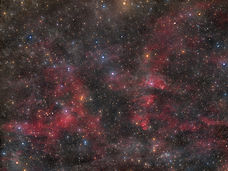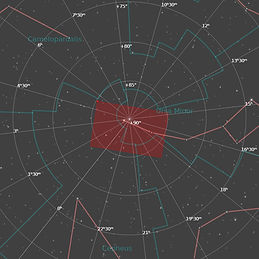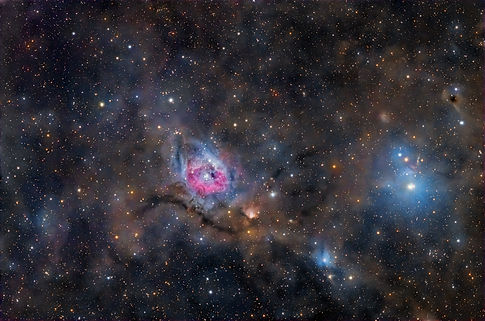Polaris Mosaic (Four Panels)

Our North Star and its surroundings look very different with long-exposure photography than they do with the naked eye. Perched high above the galactic plane, the field is filled with integrated-flux nebulas (IFNs), extended red emission (ERE), and blue luminance. The first two of those are prevalent in this image.
Polaris is actually a triple star system. Bright and visible to the naked eye, it’s 448 light years away in Ursa Minor. Less than one degree from the celestial pole, it has long been used for navigation. It’s also very difficult for many astrophotographers to shoot because of this. Tracking something so close to the pole poses numerous technical challenges.
Polaris is also the closest Cepheid variable to Earth. Cepheid variables change brightness according to predictable patterns. This has made them a key component in what astronomers call the “distance ladder” for determining how far away astronomical objects are. And it was a Cepheid variable that led Edwin Hubble to make the stunning discovery that the Andromeda nebula was not inside the Milky Way, but rather its own entity two million light years outside our galaxy. Before that, most scientists believed that the Milky Way was all there was. Hubble’s insight dramatically expanded our understanding of the nature of the universe.
As for all the gaseous striations around Polaris, they are part of a structure catalogued as Mandel-Wilson 1 (MW1). It mainly comprises a phenomenon Steve Mandel labeled integrated-flux nebula (IFN) in 2006 after seeing it in an image of M81 and M82 taken in 2005. The structure was not well studied or understood, but has since been unraveled to a greater degree. And the label IFN is now permanently affixed to this phenomenon.
Over the course of the summer, I spent several weeks exchanging emails with Dr. Adolf Witt, Distinguished Professor Emeritus at the University of Toledo and an expert on the things I relate below. I’ve done my best to simplify his explanations while maintaining their integrity. Many thanks to Steve Mandel for putting me in contact with him. It was Steve, after all, who first alerted me to what I was actually capturing with my telescopes.
IFN is primarily made up of polycyclic aromatic hydrocarbons sitting at the edge of our galaxy (far behind Polaris in this case). It neither emits its own light due to ionization like an emission nebula, or reflects light from a nearby star. Rather, it reflects the light from all the stars in the galaxy—the integrated flux.
But along with this is an even lesser-known phenomenon called extended red emission (ERE). Again, unlike emission from ionized gas, this is hydrogen that fluoresces at a deep red color. Ionized gas emits light due to the loss of electrons in its atoms. Gas that fluoresces emits light when electrons in its atoms return to a lower energy state after being excited to a higher energy state by the atoms’ absorption of external light. This likely accounts for some of the red in the image.
Further, light scattering in the IFN dust can produce blue reflections. When mixed with the ERE, this can produce a purple or burgundy color.
Another contributor to the red component of the image may be intervening ionized hydrogen gas. Galactic foreground emissions are a source of ongoing study.
In any case, until a very few years ago, I had no idea such things existed in the sky—and certainly not around the Little Dipper and Polaris, which I had observed countless times in my youth.

Finder Chart

Click to expand

Image Capture
Total integration: 102h 34m
Integration per filter:
- Lum/Clear: 27h 9m (543 × 180")
- R: 18h 57m (379 × 180")
- G: 18h 6m (362 × 180")
- B: 18h 57m (379 × 180")
- Hα: 19h 25m (233 × 300")
Coordinates: 21h 26m 30s · +88° 37′ 41″












